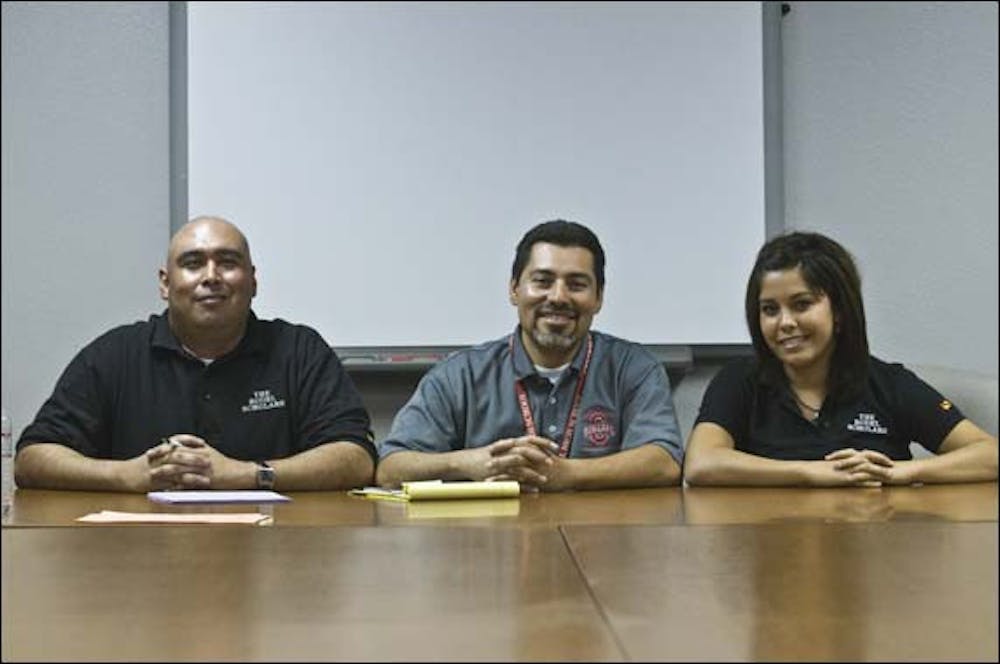As Arizona continues its struggle to keep children in school, three ASU students are working to decrease dropout rates at a local high school.
Close to 2,000 high schools nationwide were named “dropout factories” in September by the Alliance for Excellent Education for having no more than 60 percent of students who start as freshmen make it to graduation.
In Arizona, 49 high schools — almost 17 percent of the state’s high schools — are among those in the nation that are considered “dropout factories,” and Phoenix’s Central High School is one of them.
ASU students Frank Gracia, Lisette Wilson and Katrina Garcia plan to mentor 50 students from Central High School in the spring semester to expose them to University resources and highlight the value of higher education by creating skill sets workshops.
“This isn’t just about improving their graduation rates,” said Gracia, a communications senior. “We are also trying to give them hope and opportunity beyond high school.”
The three ASU students are part of the Rodel Program, a West Campus initiative that works to improve Arizona’s public education from pre-kindergarten through high school. Every year, students in the program pick an area in education they would like to improve and then work toward the goal.
This year, Gracia, Wilson and Garcia decided to target students who will be first in their families to go to college, students who Gracia said are less aware of the opportunities to help them reach higher education.
“From the feedback I’ve gotten from high school students, a lot of them think you have to be really rich or really smart to go to college,” Gracia said. “We are going to teach them that anyone can go to a university.”
Large numbers of minority and low-income students make up national “dropout factories,” producing 81 percent of all Native American dropouts, 73 percent of all African American dropouts and 66 percent of all Hispanic dropouts, according to the Alliance for Excellent Education.
Wilson, a life science senior, said she believes minority and low-income students make up a large percentage in the dropout rate because they are limited in resources that tell them where to turn for help.
Aside from limited resources, another contributing factor for students dropping out is school violence, Wilson said. As a senior in an Arizona high school, Wilson said she was bullied to the point that police got involved.
“My senior year was horrible, I don’t know how I made it through to college,” she said. “I was scared to death to go to school.”
Now she wants to focus on helping students who might be in the same situation.
Like Wilson, Garcia said violence and the influence of gang influences students to drop out.
“Dropout rates can have a lot to do with who [high school students] are hanging out with or whether they are involved in gang activities or any activity that affects their education,” Garcia said.
Researchers at Northeastern University in Boston found one in 10 male high school dropouts are in jail or juvenile detention compared to one in 35 of those who are high school graduates.
Claudio Coria, assistant principal for instruction at Central High School, said he is excited for what the Rodel students will bring to the high school.
“This will allow us to create an opportunity for our students to see successful people who have already transferred from high school to college,” Coria said. “The more connection we can make with our high school students here, the more successful students are going to be toward graduation and reducing dropouts.”
In an effort to help decrease the dropout rates in the nation, Operation HOPE, a financial literacy and empowerment nonprofit organization, launched a program on Sept. 20.
Some of the goals of the program include educating 5 million low-income youth and their guardians and teachers in financial literacy; training 25,000 HOPE Corps volunteers to teach financial literacy, dignity and entrepreneurship to students; and opening 50,000 savings accounts for youth, organization spokeswoman Sherry John said.
“This is an educational initiative to motivate students to graduate from high school and go on to college,” she said. “We want to reach out and affect as many kids as possible within a goal of five years.”
Reach the reporter at griselda.nevarez@asu.edu.




